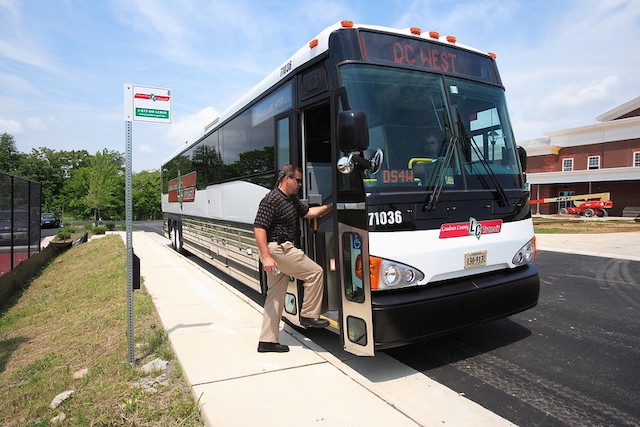Transit agencies that have been gobbling up billions of dollars of subsidies each year are now facing the prospect that hardly anyone wants to ride transit even with the subsidies. A Wall Street Journal story focuses on commuter-rail lines, which in January carried less than 35 percent of pre-pandemic riders. However, commuter-bus lines are even worse, carrying only 27 percent of pre-pandemic riders.
Loudoun County commuter buses carried less than 6 percent as many passengers to DC in January 2022 as they did in January 2020. Photo by Virginia Department of Transportation.
Individually, the worst-performing rail line is the Minneapolis North Star commuter train, which carried only 7 percent of pre-pandemic riders in January. Maryland and Virginia commuter trains serving DC, the Altamont and CalTrains commuter trains in the Bay Area, and commuter trains in Chicago and Seattle all carried less than 20 percent of pre-pandemic numbers, while trains in Los Angeles, Nashville, Philadelphia, and Connecticut were just over 20 percent. Meanwhile, commuter-bus lines in Atlanta, Milwaukee, Boston, Washington, San Francisco, Charlotte, Austin, and Sacramento all carried less than 10 percent of pre-pandemic numbers.
Commuter trains and commuter buses are hurting the most because their target market — high-income people traveling from wealthy suburbs to downtown jobs — are the most likely to be able to work at home either full time or several days a week. Other transit systems that are focused on downtowns full of high-paying jobs are also suffering, notably the Washington DC MetroRail system. According to the Washington Post, people are returning to jobs in downtown DC, but most of them are driving and MetroRail carried just 22 percent of pre-pandemic riders in January.
That’s because, so far, there is a lot less congestion and parking is more freely available than it was before the pandemic. With a large percentage of downtown employees just working two to three days a week, far more of them will be able to find parking. The Post reports that office buildings are 35 to 50 percent occupied while parking garages are 55 to 70 percent occupied. That means the area won’t run out of parking until about 80 percent of people are back to work downtown, which may never happen if large numbers of them are working at home two to three days a week.
The most detailed analysis I have seen predicts that, after the pandemic, 20 percent of people will be working at home on any given day, compared with 5 percent before the pandemic. This suggests that transit commuting is going to decline by at least 20 percent, but that’s almost certainly an underestimate. The Census Bureau says that the number of people who commuted to work by auto, bicycle, or walking in 2020 was about 13 to 15 percent less than in 2019. But the number taking transit fell by 38 percent.
There are at least two reasons why this would be so. First, people who once rode transit because roads were congested or parking was limited would switch back to driving when congestion declined and parking became available. Second, some people are no longer willing to be in crowded areas where they may be victims of either crime or infectious disease.
We can put a number on this last group thanks to a monthly survey of workers conducted by the same group that did the long-term estimate of telecommuting. Since the pandemic began, that survey has consistently shown that 10 to 15 percent of people are not going to return to their pre-COVID activities (see slide 20). It is not much of a stretch to assume that this includes 10 to 15 percent of pre-pandemic transit riders who don’t plan to ride transit again.
Based on this, my previous estimate that transit will eventually recover 75 percent of pre-pandemic riders seems high. Even 70 percent may be too high.
Transit advocates, including many urban planners, hope otherwise. “We should be concerned about” the decline in transit, a Montgomery County transportation planner told the Post. “We don’t want people to fall into a drive-to-work pattern that’s then hard to break out of.” Why not?
“Jack McDougle, CEO of the Greater Washington Board of Trade, said he expects companies to continue subsidizing transit fares,” comments the Post. Of course employers of more than 20 people in DC will do so; it’s required by law. But if most employees are working at home at least part time, some employers may get fed up with onerous DC laws and move out of the district.
Meanwhile, north of DC, the New Hampshire legislature is exhibiting a little more common sense and considering halting a proposed commuter train from Boston to Manchester. If no one is riding commuter trains, there doesn’t seem to be any need to fund more. I hope that sort of common sense spreads to the rest of the country.









Pshaw! As long as Democrats and RINOs exist, transit’s future will be bright.
GE and Suemens unveiled their new generation of battery powered locomotives….by working on high voltage charge infrastructure batteries can be fully charged in 30 minutes with a range of 300 miles.
A hybrid delivers extraordinary fuel economy by having the diesel moving the front wheels and battery power moving rear wheels. The diesel engine thus spends less time throttling…and idling. Bypassing electric power to get train going. The diesel only starts up at a sufficient rpm range. Cutting fuel consumption In half